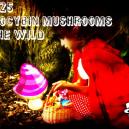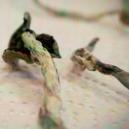How To Reuse Your Spent Mycelium Cakes
Published : June 1st, 2023

Spent mycelium cakes need not be thrown away! These little bundles of mycelium still have a whole lot to give, and can go on to produce incredibly strong mushrooms, or even be the beginning of an outdoor, wild mushroom garden. Find out all about reusing old mycelium cakes here.
Most people who cultivate magic mushrooms at home use mycelium cakes to produce their mushrooms. A healthy cake is capable of giving a lot, but at some point, they become spent and can’t produce anymore mushrooms. At this point, many growers will simply discard them, thinking them dead.
However, the mycelium in these cakes is still alive and well, and has a lot to give. But it won’t just go on producing mushrooms forever. Still, there are certain techniques you can use to get much more out of spent cakes than most people assume is possible. Find out more below.
WHAT ARE MYCELIUM CAKES?

In the world of Psilocybe cubensis cultivation, mycelium cake is the name given to the body of substrate that produces magic mushrooms. Mushroom substrates can be made of many different substances, including dung and vermiculite. They are essential to producing mushrooms, pretty much regardless of the cultivation method.
The fresh substrate is inoculated with the spores of the desired strain of mushroom, and in time, they will colonise it with mycelium. Once it’s fully colonised, mushrooms begin to grow from it. For most growers, once all the mushrooms have been harvested, all we have left are spent cakes.
But what if we could do something with our seemingly spent substrate?
HOW DO YOU KNOW WHEN MYCELIUM CAKES ARE SPENT?
It’s pretty easy to know when cakes are spent. They stop producing mushrooms. A healthy cake will probably produce between three and four flushes, though it can be as few as two and as many as six.
You’ll know they’re finished when you dunk them in water but nothing else comes out. It may be that they produce a few “aborts”, when pins appear but they don’t develop into mature mushrooms. In this case, they are also spent.
SHOULD YOU REUSE MYCELIUM CAKES?

Yes, there are several ways to reuse spent cakes. However, you can’t just go on using them forever, as you’ll find this has negative consequences eventually. First, we’ll explain a few important concepts, and then show you how to reuse spent substrate effectively.
WHAT IS COMPETITIVE EXCLUSION?
Competitive exclusion is a term describing the process whereby one organism comes to dominate a substrate. With a fully colonised cake, the mycelium is totally dominant and the chances of contamination are low. When you’ve just inoculated and the spores are incubating, on the other hand, the chances of contamination are the highest.
So using existing mycelium from spent cakes has an advantage over using spores, in that developed mycelium is one step ahead of spores, and has a greater chance of properly colonising the fresh substrate.
WHAT IS SENESCENCE?
Senescence is the same reason people get old. When genes make repeated copies of themselves, small mistakes are made, which accumulate over time. It’s like taking a photocopy of a photocopy of a photocopy. Eventually, it is unrecognisable from the original. People get wrinkles and other signs of ageing; mycelium suffers genetic decay, loses vigour, and starts to produce odd fruits.
So there’s a finite amount of times you can reuse mycelium before you start to get bad results.
HOW TO REUSE MYCELIUM CAKES

There are a few different ways to reuse spent cakes, some of which will yield fresh fruits. When reusing mycelium cakes, bear in mind the two concepts above: competitive exclusion and senescence.
INOCULATE FRESH SUBSTRATE
Spent substrate as an inoculant for a fresh substrate gives the reused mycelium a nutrient boost. When preparing a new substrate, crumble and mix the old one in with it. Incubate and fruit again. The downside of this method is that the flushes aren’t as exuberant as a first run with fresh spores. Also, the old cake has had more time to acquire pollutants or other organisms that can affect the grow.
When using older cakes to inoculate new substrates, it helps to change the type of grain being used. This prevents the mycelium from becoming dependent on a particular nutrient source and stagnating. It’s kind of like changing up workouts so muscles don’t get used to doing the same exercises every day.
The bigger the piece of recycled substrate, the better. The more mycelium already present gives it a tactical advantage in the competitive exclusion race. It can spread through the new cake substantially before spores from competing contaminants have even come to life.
MIX OLD SUBSTRATE WITH NEW SUBSTRATE (MYCELIUM CANNIBALISM)

Mixing spent substrate in with a new batch of substrate is said to produce higher-quality shrooms. It is broken up and mixed in with the new material prior to the sterilisation process, so there is no cross-contamination.
The hypothesis is that the recycled mycelium breaks down into the types of essential nutrients that new mycelium requires, while also supplying the tryptamine precursors used for psilocybin production. Ensuing flushes are more vigorous, with some anecdotal evidence suggesting that the effects are stronger as well.
TRY CASING
You can also reuse the cakes by casing them. The casing, like mulch for standard plants, will provide a moist and humid layer to encourage more mycelium growth. Depending on what type of casing is used (peat moss and coco coir are common), it can add nutrients as well as boost humidity. The flush may not be as robust as those previous, and some mutant-looking fruits can appear, but it can still work.
SPREAD THEM IN NATURE

If you have a garden with some spots that remain well-shaded, crumble the spent cakes up, spread them about, and mulch them with straw and leaf litter. Think about what a forest floor looks like. With regular watering and leaving a few fruits to mature until they naturally release their spores, you can create a successful seasonal outdoor patch. It will be subject to the whims of nature, but will produce what it can in its new home. Mycelium thrives—it is its nature. You don’t get to be around for hundreds of millions of years without being adaptable!
MULCH THEM
Mycelium cakes are great as a soil amendment or for mulching. Vermiculite, grain husks, and other organic compounds help soils retain water while increasing friability for good drainage. This is true for outdoor and indoor plants.
Crumbling them up and putting them in your houseplants over time may produce more fruits. They will observably grow slower and nowhere near as dense, as they are no longer in a pampered environment. But the more the merrier, right?
REUSING OLD MYCELIUM CAKES: HOW OFTEN SHOULD YOU DO IT?

As you can see, a spent cake is by no means finished. Ideal for inoculating fresh substrate, or for passing on their goodness to a new generation of mycelium, they can be used to produce new and strong flushes of magic mushrooms.
Otherwise, why not spread them somewhere and wait for a wild patch to appear? It may not always produce so much, but you’ll have a little wild mushroom garden. And, who knows, maybe the spores will spread and make someone else very happy!
Once the substrate finishes producing mushrooms, there’s really no need to give up on it!



















